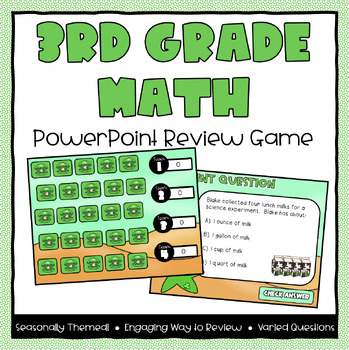3rd Grade Math St. Patrick's Day Powerpoint Review Game
Lighting Up Little Minds
1.5k Followers
Grade Levels
2nd - 4th
Subjects
Resource Type
Standards
CCSS3.MD.A.1
CCSS3.MD.B.3
CCSS3.MD.B.4
CCSS3.MD.D.8
CCSS3.NBT.A.2
Formats Included
- Zip
Pages
52 pages
Lighting Up Little Minds
1.5k Followers
Description
This product features a powerpoint review game focusing on third grade math concepts with a St. Patrick's Day theme.
Question types vary but get harder as the point value increases. Some concepts included are place value, comparing and ordering numbers, fractions, money, time, subtraction, measurement, multiplication, and patterns.
Powerpoint is fully linked to include elimination of questions already chosen, provide correct answers to questions, links back to the game board, and a score keeper for up to four teams at once.
Your students will love this interactive, visually-appealing game as a way to review their math skills!
Total Pages
52 pages
Answer Key
Included
Teaching Duration
N/A
Report this resource to TPT
Reported resources will be reviewed by our team. Report this resource to let us know if this resource violates TPT’s content guidelines.
Standards
to see state-specific standards (only available in the US).
CCSS3.MD.A.1
Tell and write time to the nearest minute and measure time intervals in minutes. Solve word problems involving addition and subtraction of time intervals in minutes, e.g., by representing the problem on a number line diagram.
CCSS3.MD.B.3
Draw a scaled picture graph and a scaled bar graph to represent a data set with several categories. Solve one- and two-step “how many more” and “how many less” problems using information presented in scaled bar graphs. For example, draw a bar graph in which each square in the bar graph might represent 5 pets.
CCSS3.MD.B.4
Generate measurement data by measuring lengths using rulers marked with halves and fourths of an inch. Show the data by making a line plot, where the horizontal scale is marked off in appropriate units-whole numbers, halves, or quarters.
CCSS3.MD.D.8
Solve real world and mathematical problems involving perimeters of polygons, including finding the perimeter given the side lengths, finding an unknown side length, and exhibiting rectangles with the same perimeter and different areas or with the same area and different perimeters.
CCSS3.NBT.A.2
Fluently add and subtract within 1000 using strategies and algorithms based on place value, properties of operations, and/or the relationship between addition and subtraction.





